Culture and Organization: Analyzing the Impact of Organizational Culture on Google Inc.
VerifiedAdded on 2023/06/10
|17
|4234
|476
AI Summary
This article analyzes the organizational culture of Google Inc. and its impact on management practices and decision making. It examines the Trompenaars and Hampden-Turners’ seven Cultural Dimensions model and its relevance in understanding cultural differences in contemporary business situations. The article also discusses the unique work culture of Google Inc. and its three distinctive features: ability to take risks, originality, and employee-friendly environment. It further explores how Google's organizational culture aligns with the Trompenaars and Hampden-Turners’ seven Cultural Dimensions model.
Contribute Materials
Your contribution can guide someone’s learning journey. Share your
documents today.
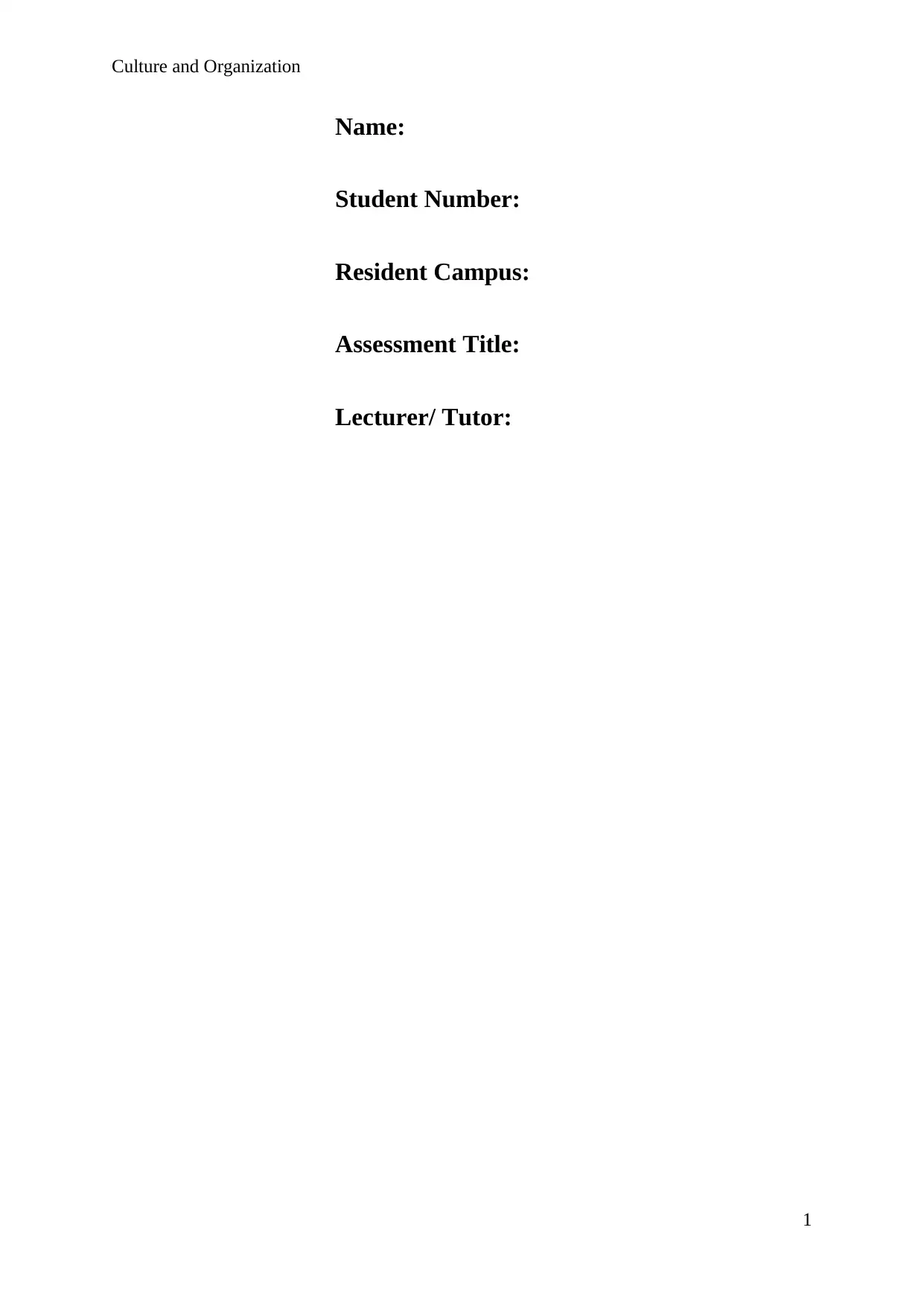
Culture and Organization
Name:
Student Number:
Resident Campus:
Assessment Title:
Lecturer/ Tutor:
1
Name:
Student Number:
Resident Campus:
Assessment Title:
Lecturer/ Tutor:
1
Secure Best Marks with AI Grader
Need help grading? Try our AI Grader for instant feedback on your assignments.
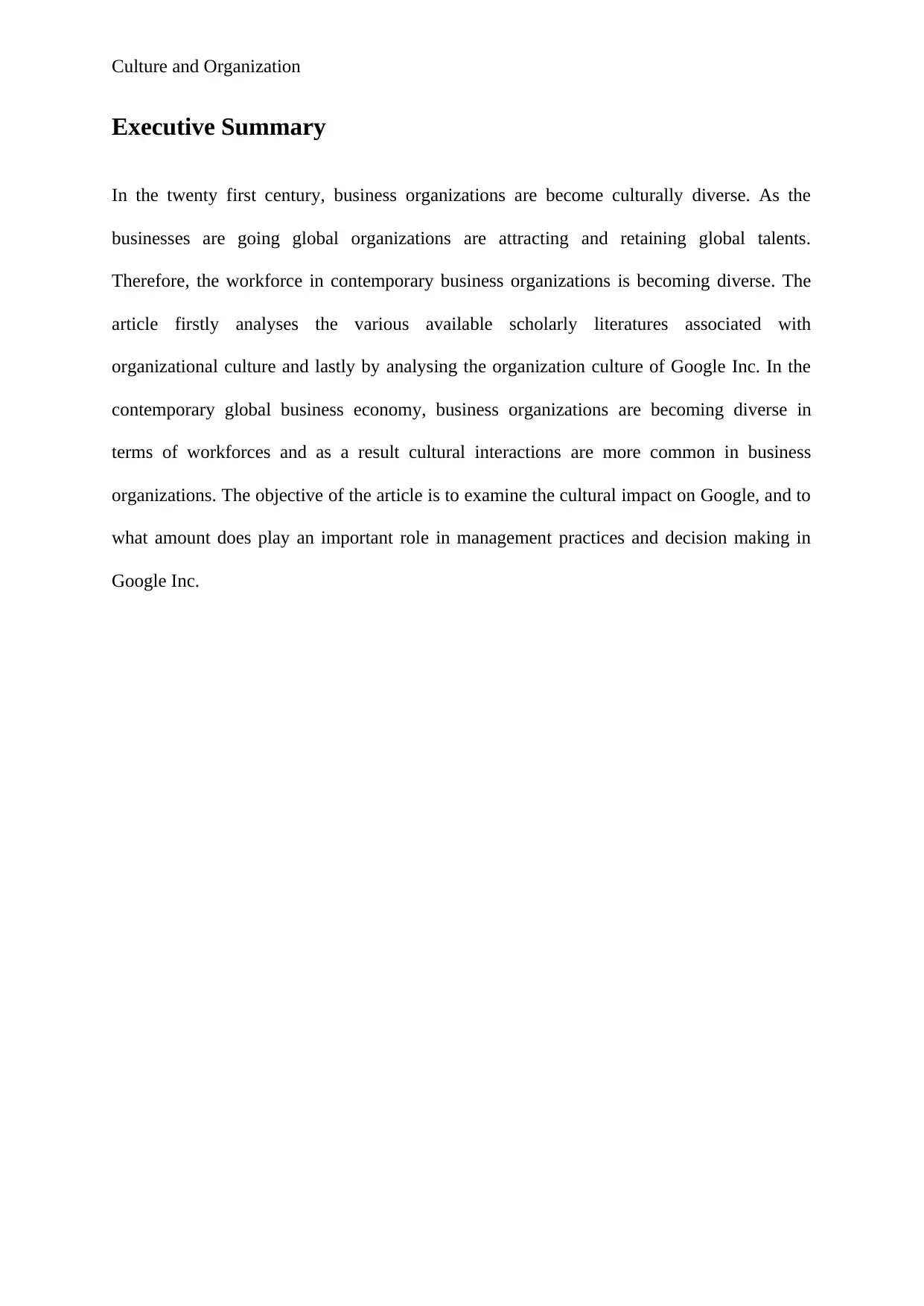
Culture and Organization
Executive Summary
In the twenty first century, business organizations are become culturally diverse. As the
businesses are going global organizations are attracting and retaining global talents.
Therefore, the workforce in contemporary business organizations is becoming diverse. The
article firstly analyses the various available scholarly literatures associated with
organizational culture and lastly by analysing the organization culture of Google Inc. In the
contemporary global business economy, business organizations are becoming diverse in
terms of workforces and as a result cultural interactions are more common in business
organizations. The objective of the article is to examine the cultural impact on Google, and to
what amount does play an important role in management practices and decision making in
Google Inc.
Executive Summary
In the twenty first century, business organizations are become culturally diverse. As the
businesses are going global organizations are attracting and retaining global talents.
Therefore, the workforce in contemporary business organizations is becoming diverse. The
article firstly analyses the various available scholarly literatures associated with
organizational culture and lastly by analysing the organization culture of Google Inc. In the
contemporary global business economy, business organizations are becoming diverse in
terms of workforces and as a result cultural interactions are more common in business
organizations. The objective of the article is to examine the cultural impact on Google, and to
what amount does play an important role in management practices and decision making in
Google Inc.
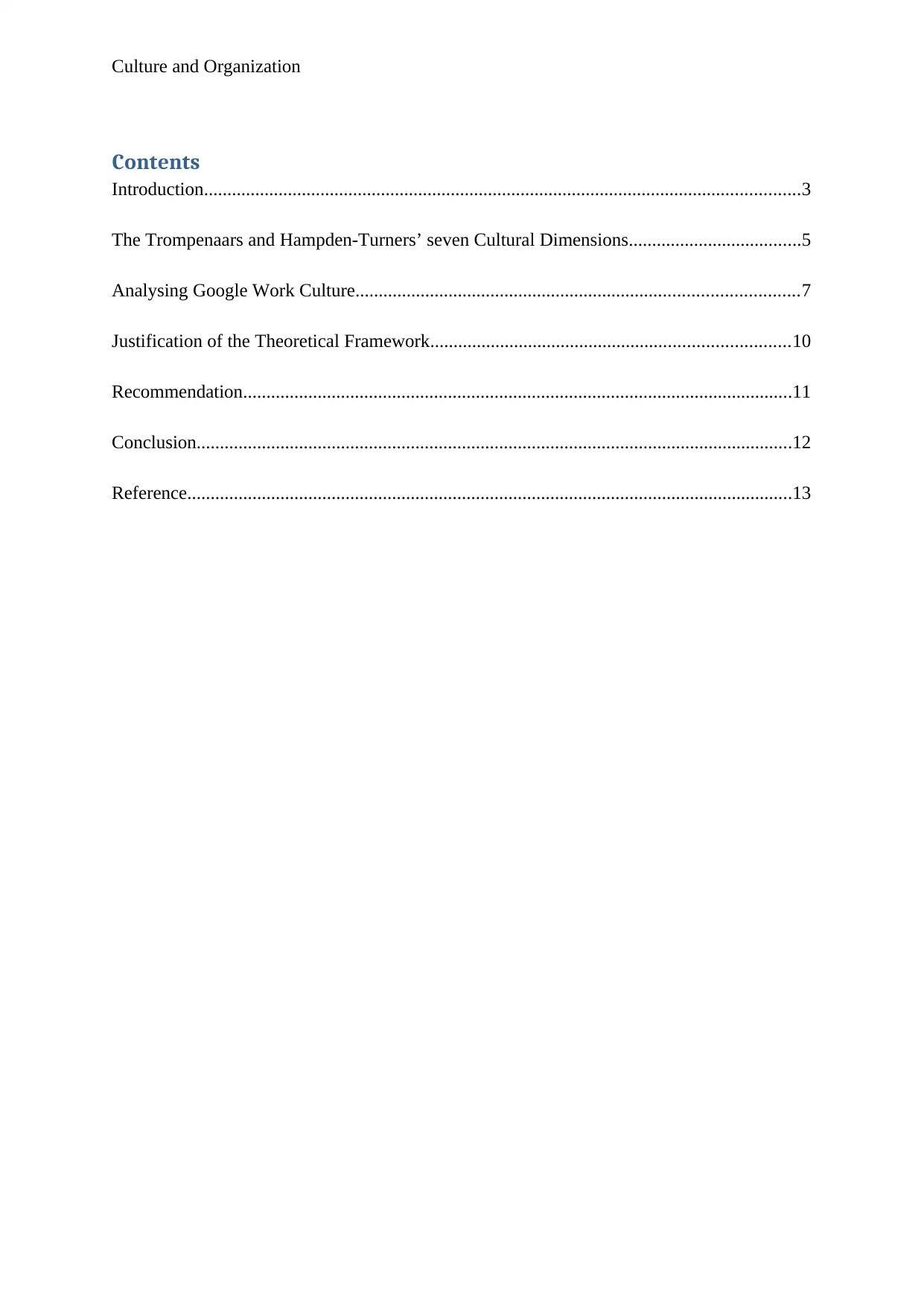
Culture and Organization
Contents
Introduction................................................................................................................................3
The Trompenaars and Hampden-Turners’ seven Cultural Dimensions.....................................5
Analysing Google Work Culture...............................................................................................7
Justification of the Theoretical Framework.............................................................................10
Recommendation......................................................................................................................11
Conclusion................................................................................................................................12
Reference..................................................................................................................................13
Contents
Introduction................................................................................................................................3
The Trompenaars and Hampden-Turners’ seven Cultural Dimensions.....................................5
Analysing Google Work Culture...............................................................................................7
Justification of the Theoretical Framework.............................................................................10
Recommendation......................................................................................................................11
Conclusion................................................................................................................................12
Reference..................................................................................................................................13
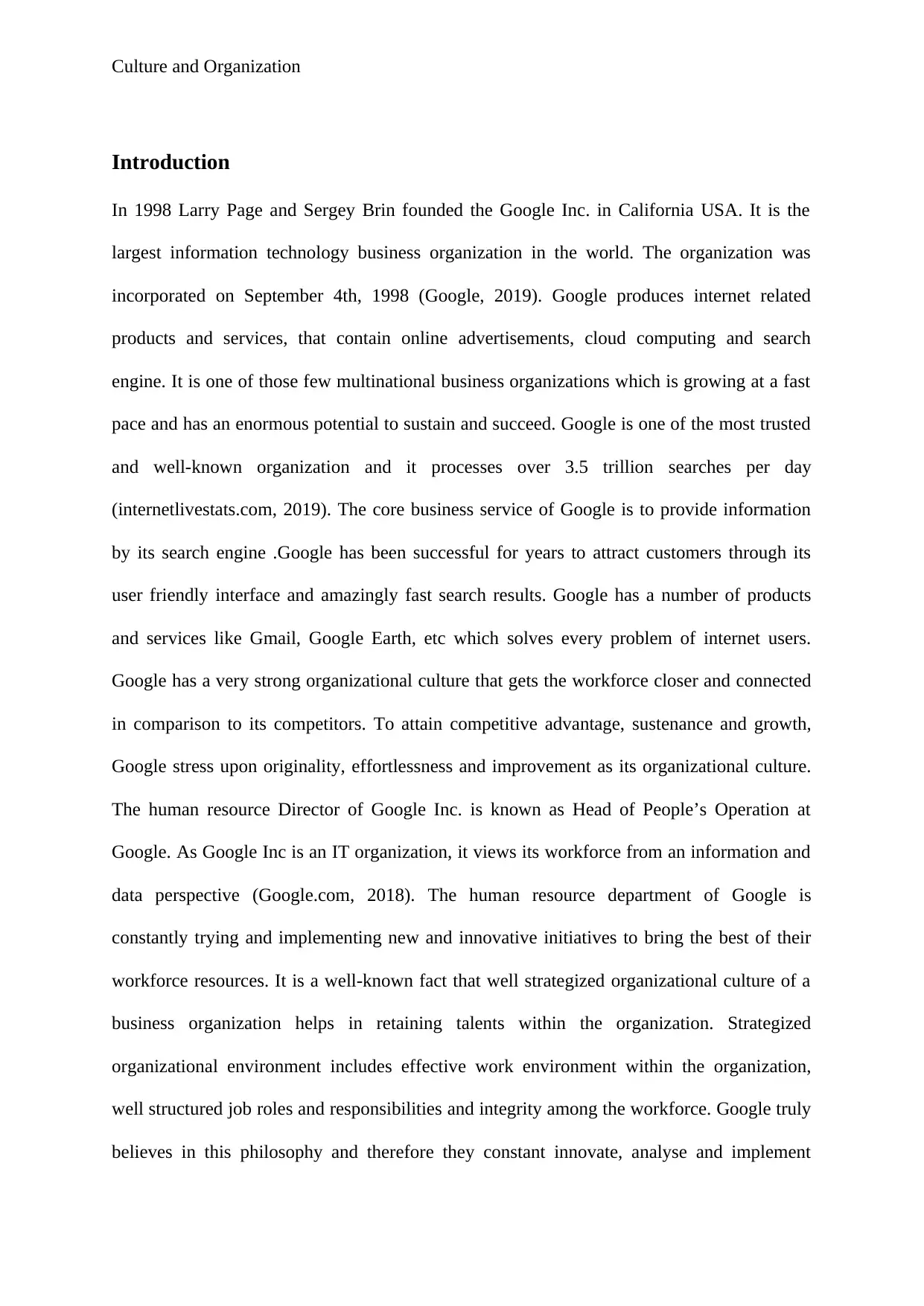
Culture and Organization
Introduction
In 1998 Larry Page and Sergey Brin founded the Google Inc. in California USA. It is the
largest information technology business organization in the world. The organization was
incorporated on September 4th, 1998 (Google, 2019). Google produces internet related
products and services, that contain online advertisements, cloud computing and search
engine. It is one of those few multinational business organizations which is growing at a fast
pace and has an enormous potential to sustain and succeed. Google is one of the most trusted
and well-known organization and it processes over 3.5 trillion searches per day
(internetlivestats.com, 2019). The core business service of Google is to provide information
by its search engine .Google has been successful for years to attract customers through its
user friendly interface and amazingly fast search results. Google has a number of products
and services like Gmail, Google Earth, etc which solves every problem of internet users.
Google has a very strong organizational culture that gets the workforce closer and connected
in comparison to its competitors. To attain competitive advantage, sustenance and growth,
Google stress upon originality, effortlessness and improvement as its organizational culture.
The human resource Director of Google Inc. is known as Head of People’s Operation at
Google. As Google Inc is an IT organization, it views its workforce from an information and
data perspective (Google.com, 2018). The human resource department of Google is
constantly trying and implementing new and innovative initiatives to bring the best of their
workforce resources. It is a well-known fact that well strategized organizational culture of a
business organization helps in retaining talents within the organization. Strategized
organizational environment includes effective work environment within the organization,
well structured job roles and responsibilities and integrity among the workforce. Google truly
believes in this philosophy and therefore they constant innovate, analyse and implement
Introduction
In 1998 Larry Page and Sergey Brin founded the Google Inc. in California USA. It is the
largest information technology business organization in the world. The organization was
incorporated on September 4th, 1998 (Google, 2019). Google produces internet related
products and services, that contain online advertisements, cloud computing and search
engine. It is one of those few multinational business organizations which is growing at a fast
pace and has an enormous potential to sustain and succeed. Google is one of the most trusted
and well-known organization and it processes over 3.5 trillion searches per day
(internetlivestats.com, 2019). The core business service of Google is to provide information
by its search engine .Google has been successful for years to attract customers through its
user friendly interface and amazingly fast search results. Google has a number of products
and services like Gmail, Google Earth, etc which solves every problem of internet users.
Google has a very strong organizational culture that gets the workforce closer and connected
in comparison to its competitors. To attain competitive advantage, sustenance and growth,
Google stress upon originality, effortlessness and improvement as its organizational culture.
The human resource Director of Google Inc. is known as Head of People’s Operation at
Google. As Google Inc is an IT organization, it views its workforce from an information and
data perspective (Google.com, 2018). The human resource department of Google is
constantly trying and implementing new and innovative initiatives to bring the best of their
workforce resources. It is a well-known fact that well strategized organizational culture of a
business organization helps in retaining talents within the organization. Strategized
organizational environment includes effective work environment within the organization,
well structured job roles and responsibilities and integrity among the workforce. Google truly
believes in this philosophy and therefore they constant innovate, analyse and implement
Secure Best Marks with AI Grader
Need help grading? Try our AI Grader for instant feedback on your assignments.
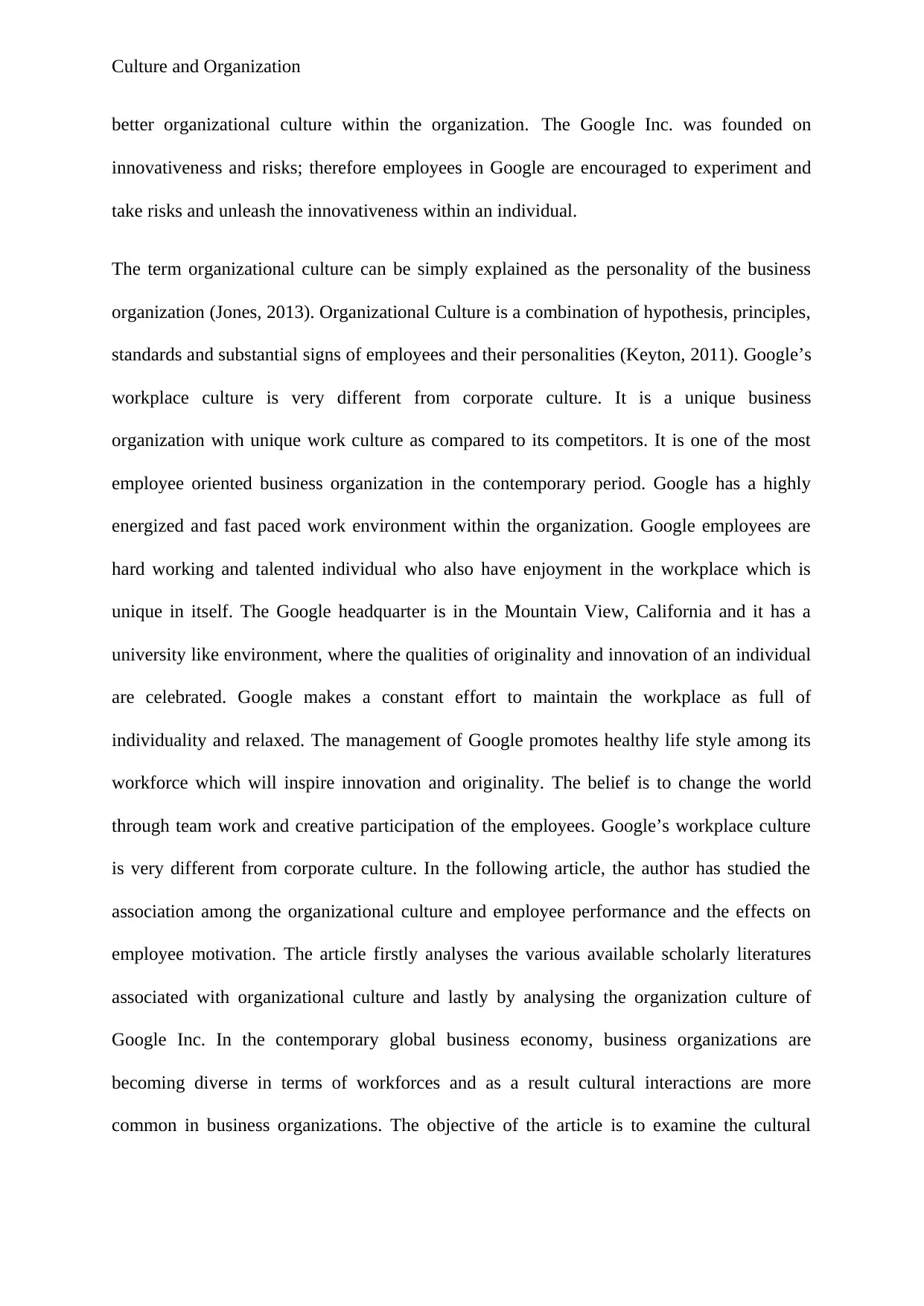
Culture and Organization
better organizational culture within the organization. The Google Inc. was founded on
innovativeness and risks; therefore employees in Google are encouraged to experiment and
take risks and unleash the innovativeness within an individual.
The term organizational culture can be simply explained as the personality of the business
organization (Jones, 2013). Organizational Culture is a combination of hypothesis, principles,
standards and substantial signs of employees and their personalities (Keyton, 2011). Google’s
workplace culture is very different from corporate culture. It is a unique business
organization with unique work culture as compared to its competitors. It is one of the most
employee oriented business organization in the contemporary period. Google has a highly
energized and fast paced work environment within the organization. Google employees are
hard working and talented individual who also have enjoyment in the workplace which is
unique in itself. The Google headquarter is in the Mountain View, California and it has a
university like environment, where the qualities of originality and innovation of an individual
are celebrated. Google makes a constant effort to maintain the workplace as full of
individuality and relaxed. The management of Google promotes healthy life style among its
workforce which will inspire innovation and originality. The belief is to change the world
through team work and creative participation of the employees. Google’s workplace culture
is very different from corporate culture. In the following article, the author has studied the
association among the organizational culture and employee performance and the effects on
employee motivation. The article firstly analyses the various available scholarly literatures
associated with organizational culture and lastly by analysing the organization culture of
Google Inc. In the contemporary global business economy, business organizations are
becoming diverse in terms of workforces and as a result cultural interactions are more
common in business organizations. The objective of the article is to examine the cultural
better organizational culture within the organization. The Google Inc. was founded on
innovativeness and risks; therefore employees in Google are encouraged to experiment and
take risks and unleash the innovativeness within an individual.
The term organizational culture can be simply explained as the personality of the business
organization (Jones, 2013). Organizational Culture is a combination of hypothesis, principles,
standards and substantial signs of employees and their personalities (Keyton, 2011). Google’s
workplace culture is very different from corporate culture. It is a unique business
organization with unique work culture as compared to its competitors. It is one of the most
employee oriented business organization in the contemporary period. Google has a highly
energized and fast paced work environment within the organization. Google employees are
hard working and talented individual who also have enjoyment in the workplace which is
unique in itself. The Google headquarter is in the Mountain View, California and it has a
university like environment, where the qualities of originality and innovation of an individual
are celebrated. Google makes a constant effort to maintain the workplace as full of
individuality and relaxed. The management of Google promotes healthy life style among its
workforce which will inspire innovation and originality. The belief is to change the world
through team work and creative participation of the employees. Google’s workplace culture
is very different from corporate culture. In the following article, the author has studied the
association among the organizational culture and employee performance and the effects on
employee motivation. The article firstly analyses the various available scholarly literatures
associated with organizational culture and lastly by analysing the organization culture of
Google Inc. In the contemporary global business economy, business organizations are
becoming diverse in terms of workforces and as a result cultural interactions are more
common in business organizations. The objective of the article is to examine the cultural
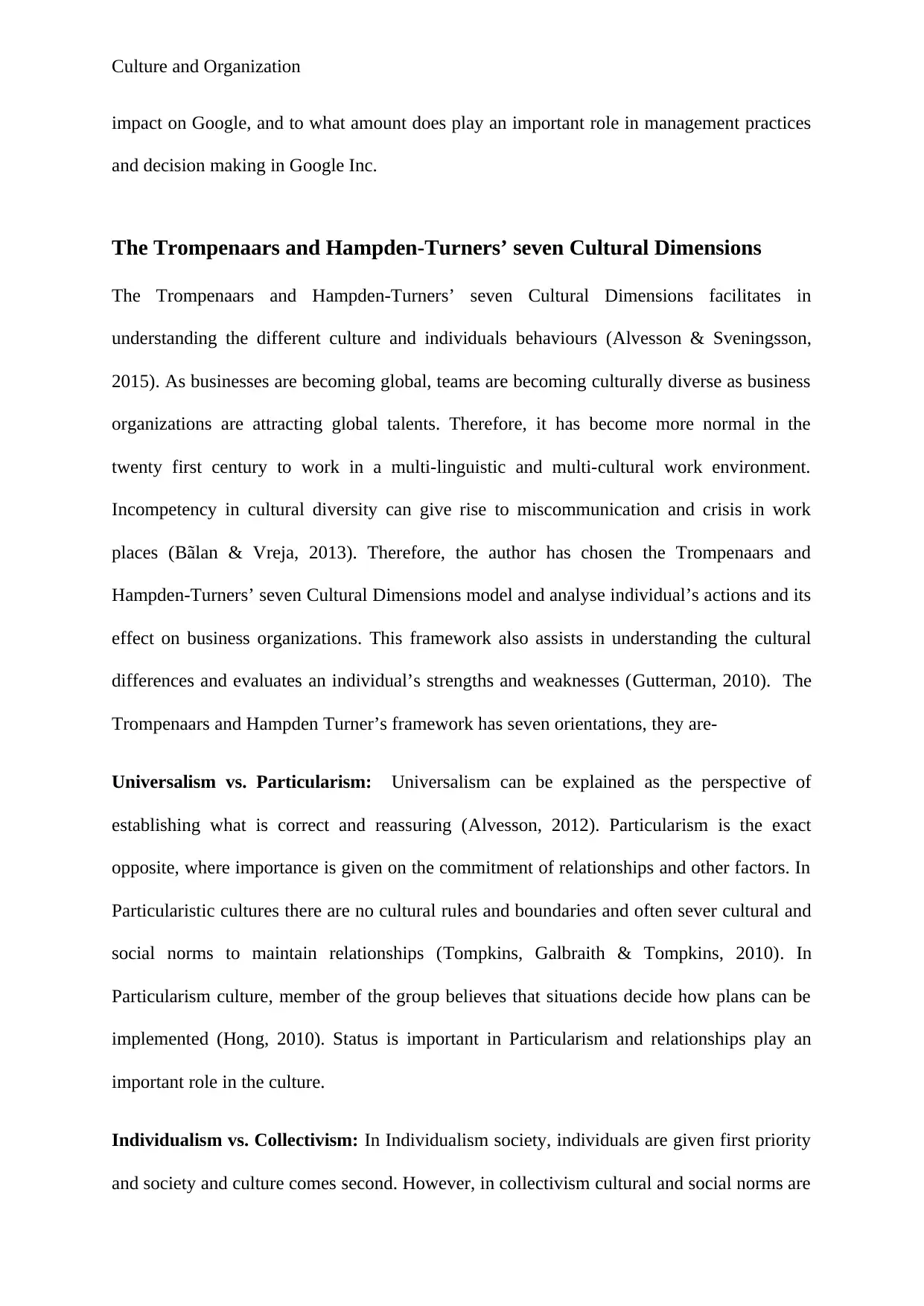
Culture and Organization
impact on Google, and to what amount does play an important role in management practices
and decision making in Google Inc.
The Trompenaars and Hampden-Turners’ seven Cultural Dimensions
The Trompenaars and Hampden-Turners’ seven Cultural Dimensions facilitates in
understanding the different culture and individuals behaviours (Alvesson & Sveningsson,
2015). As businesses are becoming global, teams are becoming culturally diverse as business
organizations are attracting global talents. Therefore, it has become more normal in the
twenty first century to work in a multi-linguistic and multi-cultural work environment.
Incompetency in cultural diversity can give rise to miscommunication and crisis in work
places (Bãlan & Vreja, 2013). Therefore, the author has chosen the Trompenaars and
Hampden-Turners’ seven Cultural Dimensions model and analyse individual’s actions and its
effect on business organizations. This framework also assists in understanding the cultural
differences and evaluates an individual’s strengths and weaknesses (Gutterman, 2010). The
Trompenaars and Hampden Turner’s framework has seven orientations, they are-
Universalism vs. Particularism: Universalism can be explained as the perspective of
establishing what is correct and reassuring (Alvesson, 2012). Particularism is the exact
opposite, where importance is given on the commitment of relationships and other factors. In
Particularistic cultures there are no cultural rules and boundaries and often sever cultural and
social norms to maintain relationships (Tompkins, Galbraith & Tompkins, 2010). In
Particularism culture, member of the group believes that situations decide how plans can be
implemented (Hong, 2010). Status is important in Particularism and relationships play an
important role in the culture.
Individualism vs. Collectivism: In Individualism society, individuals are given first priority
and society and culture comes second. However, in collectivism cultural and social norms are
impact on Google, and to what amount does play an important role in management practices
and decision making in Google Inc.
The Trompenaars and Hampden-Turners’ seven Cultural Dimensions
The Trompenaars and Hampden-Turners’ seven Cultural Dimensions facilitates in
understanding the different culture and individuals behaviours (Alvesson & Sveningsson,
2015). As businesses are becoming global, teams are becoming culturally diverse as business
organizations are attracting global talents. Therefore, it has become more normal in the
twenty first century to work in a multi-linguistic and multi-cultural work environment.
Incompetency in cultural diversity can give rise to miscommunication and crisis in work
places (Bãlan & Vreja, 2013). Therefore, the author has chosen the Trompenaars and
Hampden-Turners’ seven Cultural Dimensions model and analyse individual’s actions and its
effect on business organizations. This framework also assists in understanding the cultural
differences and evaluates an individual’s strengths and weaknesses (Gutterman, 2010). The
Trompenaars and Hampden Turner’s framework has seven orientations, they are-
Universalism vs. Particularism: Universalism can be explained as the perspective of
establishing what is correct and reassuring (Alvesson, 2012). Particularism is the exact
opposite, where importance is given on the commitment of relationships and other factors. In
Particularistic cultures there are no cultural rules and boundaries and often sever cultural and
social norms to maintain relationships (Tompkins, Galbraith & Tompkins, 2010). In
Particularism culture, member of the group believes that situations decide how plans can be
implemented (Hong, 2010). Status is important in Particularism and relationships play an
important role in the culture.
Individualism vs. Collectivism: In Individualism society, individuals are given first priority
and society and culture comes second. However, in collectivism cultural and social norms are
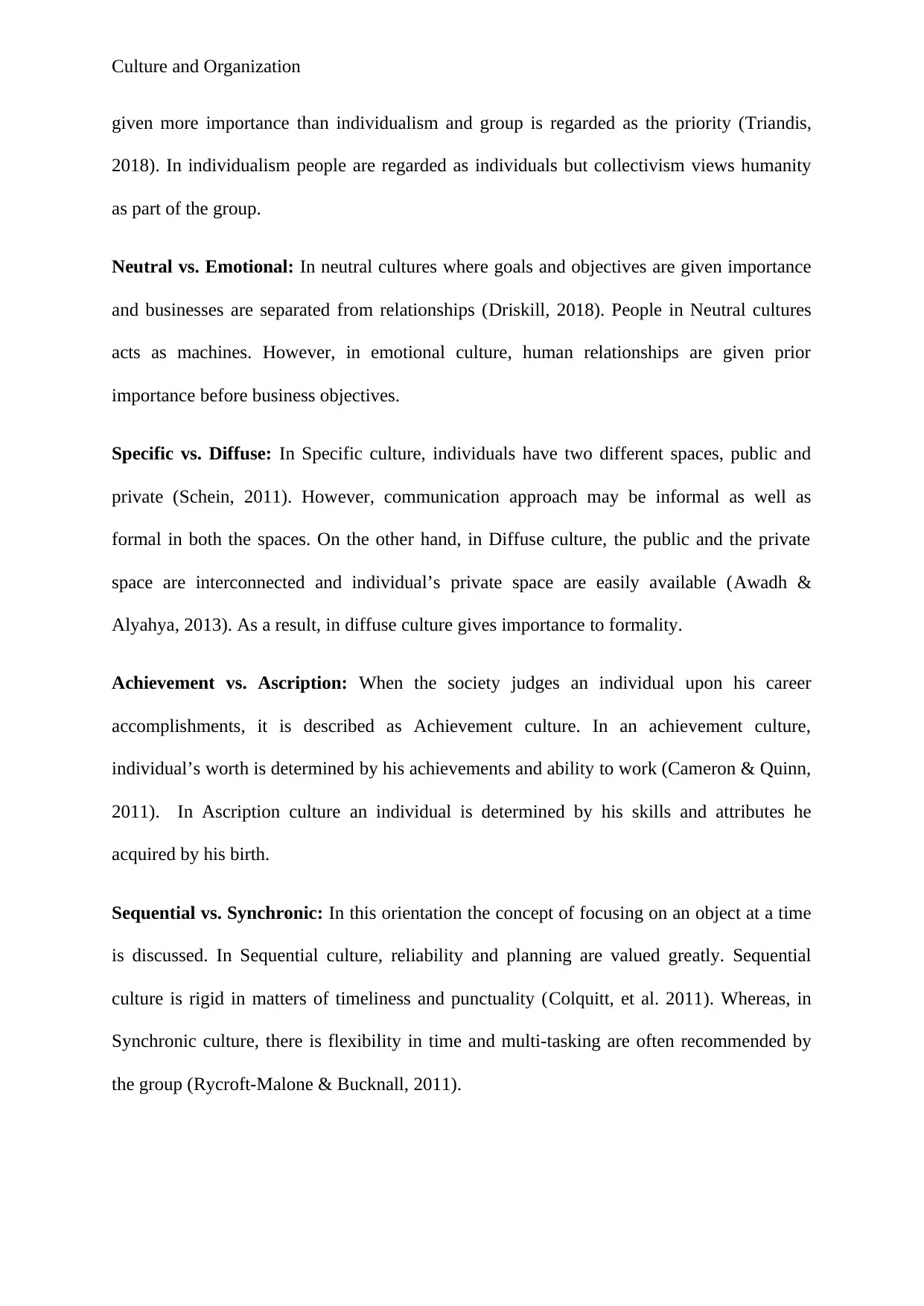
Culture and Organization
given more importance than individualism and group is regarded as the priority (Triandis,
2018). In individualism people are regarded as individuals but collectivism views humanity
as part of the group.
Neutral vs. Emotional: In neutral cultures where goals and objectives are given importance
and businesses are separated from relationships (Driskill, 2018). People in Neutral cultures
acts as machines. However, in emotional culture, human relationships are given prior
importance before business objectives.
Specific vs. Diffuse: In Specific culture, individuals have two different spaces, public and
private (Schein, 2011). However, communication approach may be informal as well as
formal in both the spaces. On the other hand, in Diffuse culture, the public and the private
space are interconnected and individual’s private space are easily available (Awadh &
Alyahya, 2013). As a result, in diffuse culture gives importance to formality.
Achievement vs. Ascription: When the society judges an individual upon his career
accomplishments, it is described as Achievement culture. In an achievement culture,
individual’s worth is determined by his achievements and ability to work (Cameron & Quinn,
2011). In Ascription culture an individual is determined by his skills and attributes he
acquired by his birth.
Sequential vs. Synchronic: In this orientation the concept of focusing on an object at a time
is discussed. In Sequential culture, reliability and planning are valued greatly. Sequential
culture is rigid in matters of timeliness and punctuality (Colquitt, et al. 2011). Whereas, in
Synchronic culture, there is flexibility in time and multi-tasking are often recommended by
the group (Rycroft-Malone & Bucknall, 2011).
given more importance than individualism and group is regarded as the priority (Triandis,
2018). In individualism people are regarded as individuals but collectivism views humanity
as part of the group.
Neutral vs. Emotional: In neutral cultures where goals and objectives are given importance
and businesses are separated from relationships (Driskill, 2018). People in Neutral cultures
acts as machines. However, in emotional culture, human relationships are given prior
importance before business objectives.
Specific vs. Diffuse: In Specific culture, individuals have two different spaces, public and
private (Schein, 2011). However, communication approach may be informal as well as
formal in both the spaces. On the other hand, in Diffuse culture, the public and the private
space are interconnected and individual’s private space are easily available (Awadh &
Alyahya, 2013). As a result, in diffuse culture gives importance to formality.
Achievement vs. Ascription: When the society judges an individual upon his career
accomplishments, it is described as Achievement culture. In an achievement culture,
individual’s worth is determined by his achievements and ability to work (Cameron & Quinn,
2011). In Ascription culture an individual is determined by his skills and attributes he
acquired by his birth.
Sequential vs. Synchronic: In this orientation the concept of focusing on an object at a time
is discussed. In Sequential culture, reliability and planning are valued greatly. Sequential
culture is rigid in matters of timeliness and punctuality (Colquitt, et al. 2011). Whereas, in
Synchronic culture, there is flexibility in time and multi-tasking are often recommended by
the group (Rycroft-Malone & Bucknall, 2011).
Paraphrase This Document
Need a fresh take? Get an instant paraphrase of this document with our AI Paraphraser
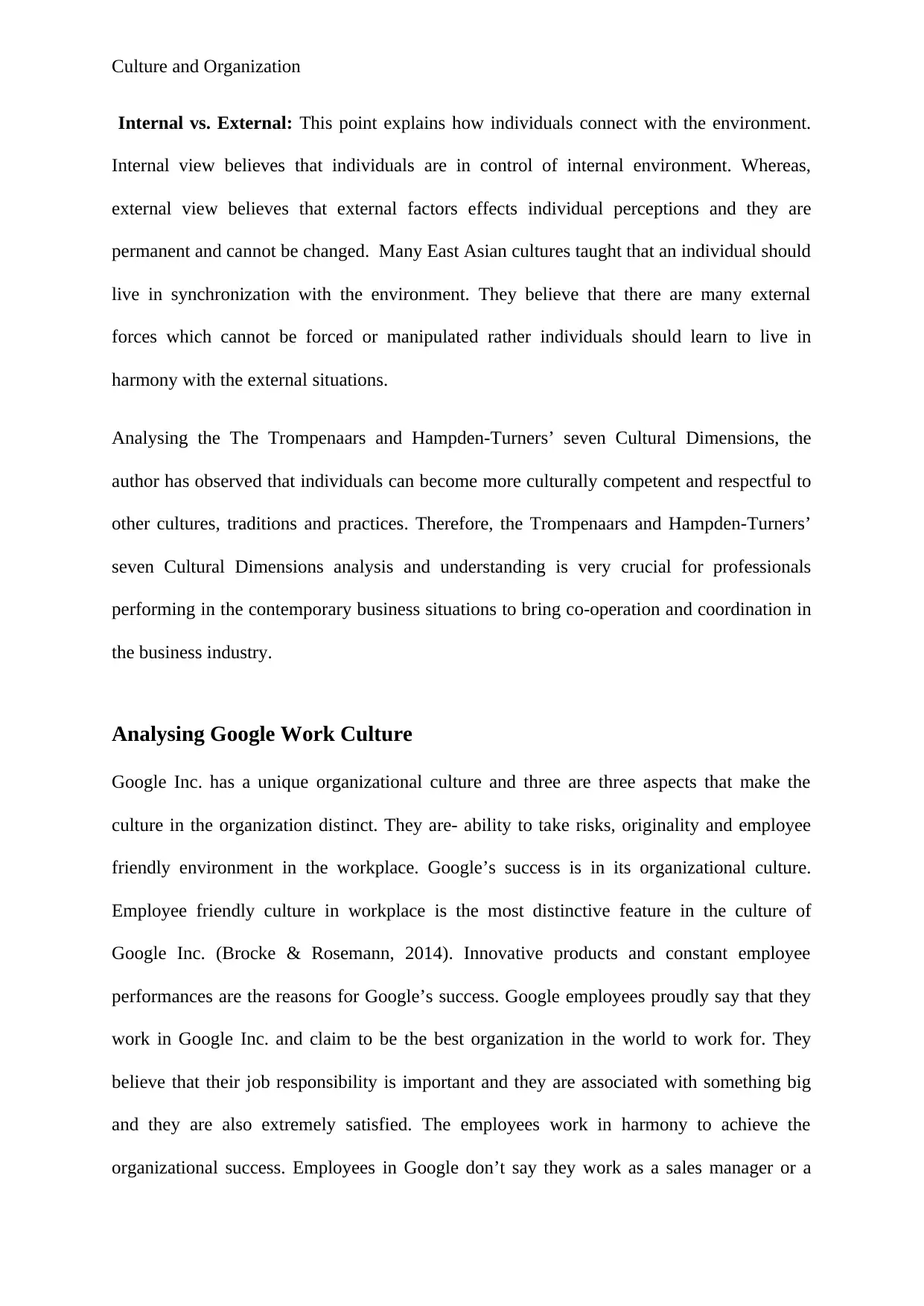
Culture and Organization
Internal vs. External: This point explains how individuals connect with the environment.
Internal view believes that individuals are in control of internal environment. Whereas,
external view believes that external factors effects individual perceptions and they are
permanent and cannot be changed. Many East Asian cultures taught that an individual should
live in synchronization with the environment. They believe that there are many external
forces which cannot be forced or manipulated rather individuals should learn to live in
harmony with the external situations.
Analysing the The Trompenaars and Hampden-Turners’ seven Cultural Dimensions, the
author has observed that individuals can become more culturally competent and respectful to
other cultures, traditions and practices. Therefore, the Trompenaars and Hampden-Turners’
seven Cultural Dimensions analysis and understanding is very crucial for professionals
performing in the contemporary business situations to bring co-operation and coordination in
the business industry.
Analysing Google Work Culture
Google Inc. has a unique organizational culture and three are three aspects that make the
culture in the organization distinct. They are- ability to take risks, originality and employee
friendly environment in the workplace. Google’s success is in its organizational culture.
Employee friendly culture in workplace is the most distinctive feature in the culture of
Google Inc. (Brocke & Rosemann, 2014). Innovative products and constant employee
performances are the reasons for Google’s success. Google employees proudly say that they
work in Google Inc. and claim to be the best organization in the world to work for. They
believe that their job responsibility is important and they are associated with something big
and they are also extremely satisfied. The employees work in harmony to achieve the
organizational success. Employees in Google don’t say they work as a sales manager or a
Internal vs. External: This point explains how individuals connect with the environment.
Internal view believes that individuals are in control of internal environment. Whereas,
external view believes that external factors effects individual perceptions and they are
permanent and cannot be changed. Many East Asian cultures taught that an individual should
live in synchronization with the environment. They believe that there are many external
forces which cannot be forced or manipulated rather individuals should learn to live in
harmony with the external situations.
Analysing the The Trompenaars and Hampden-Turners’ seven Cultural Dimensions, the
author has observed that individuals can become more culturally competent and respectful to
other cultures, traditions and practices. Therefore, the Trompenaars and Hampden-Turners’
seven Cultural Dimensions analysis and understanding is very crucial for professionals
performing in the contemporary business situations to bring co-operation and coordination in
the business industry.
Analysing Google Work Culture
Google Inc. has a unique organizational culture and three are three aspects that make the
culture in the organization distinct. They are- ability to take risks, originality and employee
friendly environment in the workplace. Google’s success is in its organizational culture.
Employee friendly culture in workplace is the most distinctive feature in the culture of
Google Inc. (Brocke & Rosemann, 2014). Innovative products and constant employee
performances are the reasons for Google’s success. Google employees proudly say that they
work in Google Inc. and claim to be the best organization in the world to work for. They
believe that their job responsibility is important and they are associated with something big
and they are also extremely satisfied. The employees work in harmony to achieve the
organizational success. Employees in Google don’t say they work as a sales manager or a
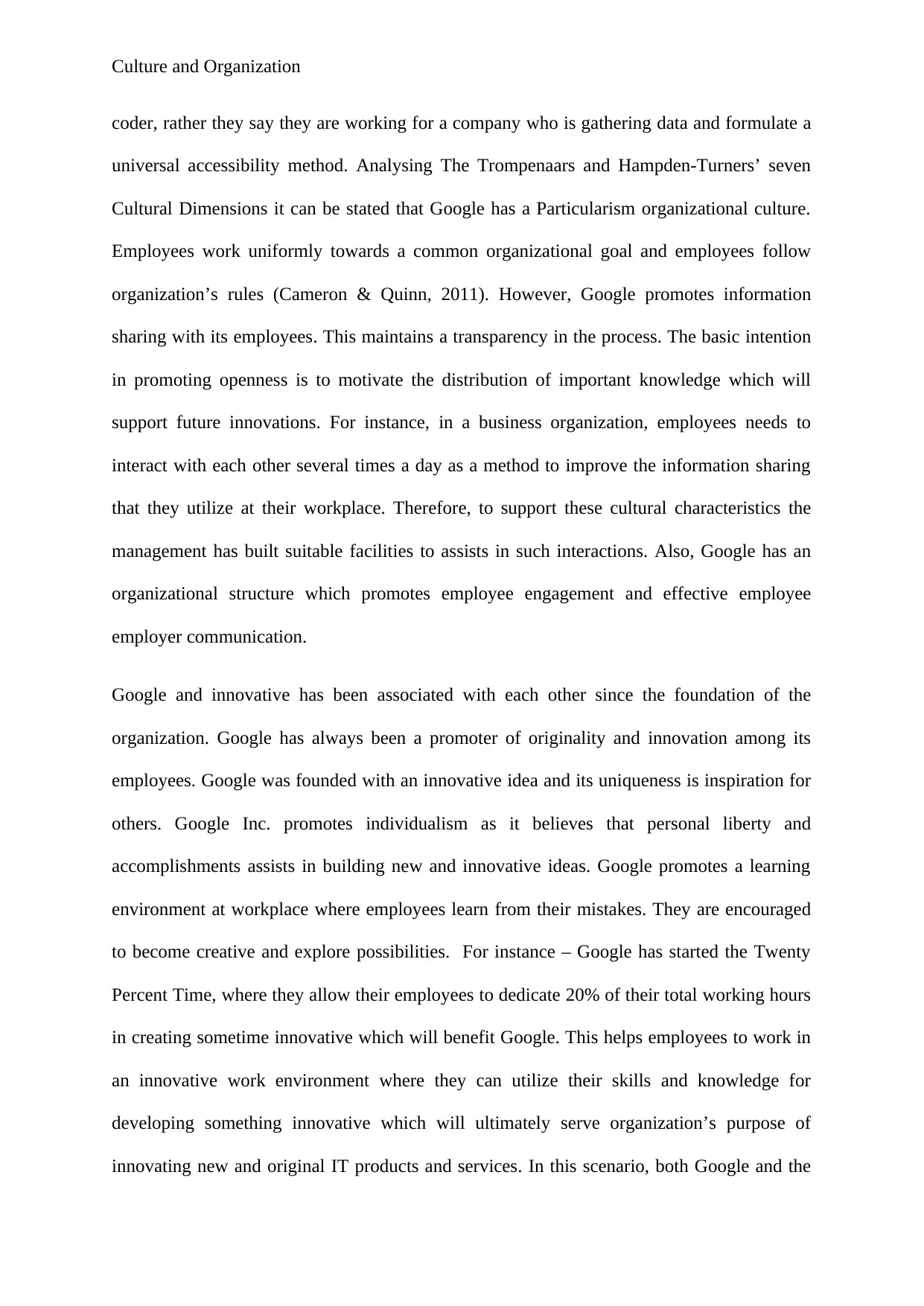
Culture and Organization
coder, rather they say they are working for a company who is gathering data and formulate a
universal accessibility method. Analysing The Trompenaars and Hampden-Turners’ seven
Cultural Dimensions it can be stated that Google has a Particularism organizational culture.
Employees work uniformly towards a common organizational goal and employees follow
organization’s rules (Cameron & Quinn, 2011). However, Google promotes information
sharing with its employees. This maintains a transparency in the process. The basic intention
in promoting openness is to motivate the distribution of important knowledge which will
support future innovations. For instance, in a business organization, employees needs to
interact with each other several times a day as a method to improve the information sharing
that they utilize at their workplace. Therefore, to support these cultural characteristics the
management has built suitable facilities to assists in such interactions. Also, Google has an
organizational structure which promotes employee engagement and effective employee
employer communication.
Google and innovative has been associated with each other since the foundation of the
organization. Google has always been a promoter of originality and innovation among its
employees. Google was founded with an innovative idea and its uniqueness is inspiration for
others. Google Inc. promotes individualism as it believes that personal liberty and
accomplishments assists in building new and innovative ideas. Google promotes a learning
environment at workplace where employees learn from their mistakes. They are encouraged
to become creative and explore possibilities. For instance – Google has started the Twenty
Percent Time, where they allow their employees to dedicate 20% of their total working hours
in creating sometime innovative which will benefit Google. This helps employees to work in
an innovative work environment where they can utilize their skills and knowledge for
developing something innovative which will ultimately serve organization’s purpose of
innovating new and original IT products and services. In this scenario, both Google and the
coder, rather they say they are working for a company who is gathering data and formulate a
universal accessibility method. Analysing The Trompenaars and Hampden-Turners’ seven
Cultural Dimensions it can be stated that Google has a Particularism organizational culture.
Employees work uniformly towards a common organizational goal and employees follow
organization’s rules (Cameron & Quinn, 2011). However, Google promotes information
sharing with its employees. This maintains a transparency in the process. The basic intention
in promoting openness is to motivate the distribution of important knowledge which will
support future innovations. For instance, in a business organization, employees needs to
interact with each other several times a day as a method to improve the information sharing
that they utilize at their workplace. Therefore, to support these cultural characteristics the
management has built suitable facilities to assists in such interactions. Also, Google has an
organizational structure which promotes employee engagement and effective employee
employer communication.
Google and innovative has been associated with each other since the foundation of the
organization. Google has always been a promoter of originality and innovation among its
employees. Google was founded with an innovative idea and its uniqueness is inspiration for
others. Google Inc. promotes individualism as it believes that personal liberty and
accomplishments assists in building new and innovative ideas. Google promotes a learning
environment at workplace where employees learn from their mistakes. They are encouraged
to become creative and explore possibilities. For instance – Google has started the Twenty
Percent Time, where they allow their employees to dedicate 20% of their total working hours
in creating sometime innovative which will benefit Google. This helps employees to work in
an innovative work environment where they can utilize their skills and knowledge for
developing something innovative which will ultimately serve organization’s purpose of
innovating new and original IT products and services. In this scenario, both Google and the
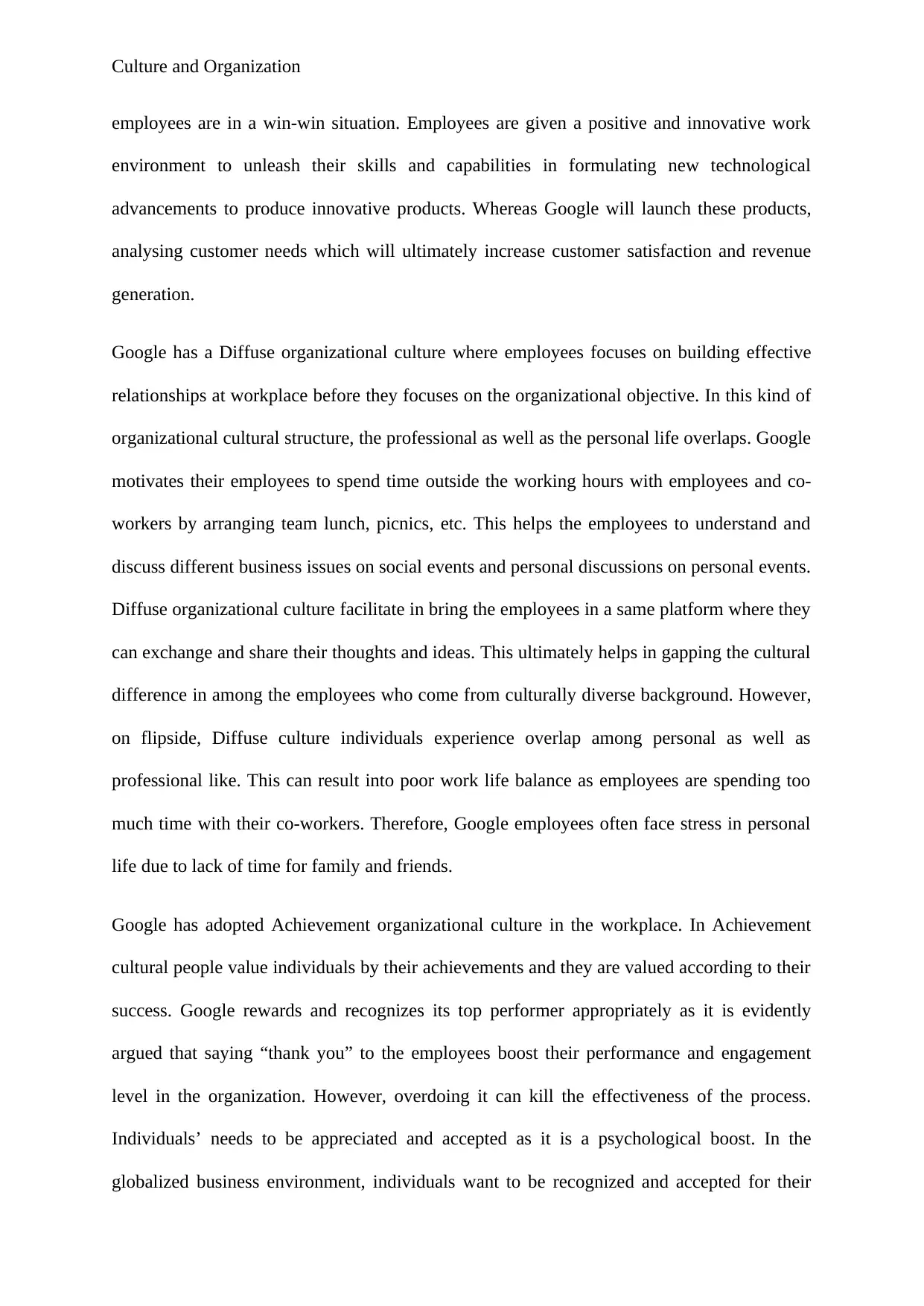
Culture and Organization
employees are in a win-win situation. Employees are given a positive and innovative work
environment to unleash their skills and capabilities in formulating new technological
advancements to produce innovative products. Whereas Google will launch these products,
analysing customer needs which will ultimately increase customer satisfaction and revenue
generation.
Google has a Diffuse organizational culture where employees focuses on building effective
relationships at workplace before they focuses on the organizational objective. In this kind of
organizational cultural structure, the professional as well as the personal life overlaps. Google
motivates their employees to spend time outside the working hours with employees and co-
workers by arranging team lunch, picnics, etc. This helps the employees to understand and
discuss different business issues on social events and personal discussions on personal events.
Diffuse organizational culture facilitate in bring the employees in a same platform where they
can exchange and share their thoughts and ideas. This ultimately helps in gapping the cultural
difference in among the employees who come from culturally diverse background. However,
on flipside, Diffuse culture individuals experience overlap among personal as well as
professional like. This can result into poor work life balance as employees are spending too
much time with their co-workers. Therefore, Google employees often face stress in personal
life due to lack of time for family and friends.
Google has adopted Achievement organizational culture in the workplace. In Achievement
cultural people value individuals by their achievements and they are valued according to their
success. Google rewards and recognizes its top performer appropriately as it is evidently
argued that saying “thank you” to the employees boost their performance and engagement
level in the organization. However, overdoing it can kill the effectiveness of the process.
Individuals’ needs to be appreciated and accepted as it is a psychological boost. In the
globalized business environment, individuals want to be recognized and accepted for their
employees are in a win-win situation. Employees are given a positive and innovative work
environment to unleash their skills and capabilities in formulating new technological
advancements to produce innovative products. Whereas Google will launch these products,
analysing customer needs which will ultimately increase customer satisfaction and revenue
generation.
Google has a Diffuse organizational culture where employees focuses on building effective
relationships at workplace before they focuses on the organizational objective. In this kind of
organizational cultural structure, the professional as well as the personal life overlaps. Google
motivates their employees to spend time outside the working hours with employees and co-
workers by arranging team lunch, picnics, etc. This helps the employees to understand and
discuss different business issues on social events and personal discussions on personal events.
Diffuse organizational culture facilitate in bring the employees in a same platform where they
can exchange and share their thoughts and ideas. This ultimately helps in gapping the cultural
difference in among the employees who come from culturally diverse background. However,
on flipside, Diffuse culture individuals experience overlap among personal as well as
professional like. This can result into poor work life balance as employees are spending too
much time with their co-workers. Therefore, Google employees often face stress in personal
life due to lack of time for family and friends.
Google has adopted Achievement organizational culture in the workplace. In Achievement
cultural people value individuals by their achievements and they are valued according to their
success. Google rewards and recognizes its top performer appropriately as it is evidently
argued that saying “thank you” to the employees boost their performance and engagement
level in the organization. However, overdoing it can kill the effectiveness of the process.
Individuals’ needs to be appreciated and accepted as it is a psychological boost. In the
globalized business environment, individuals want to be recognized and accepted for their
Secure Best Marks with AI Grader
Need help grading? Try our AI Grader for instant feedback on your assignments.
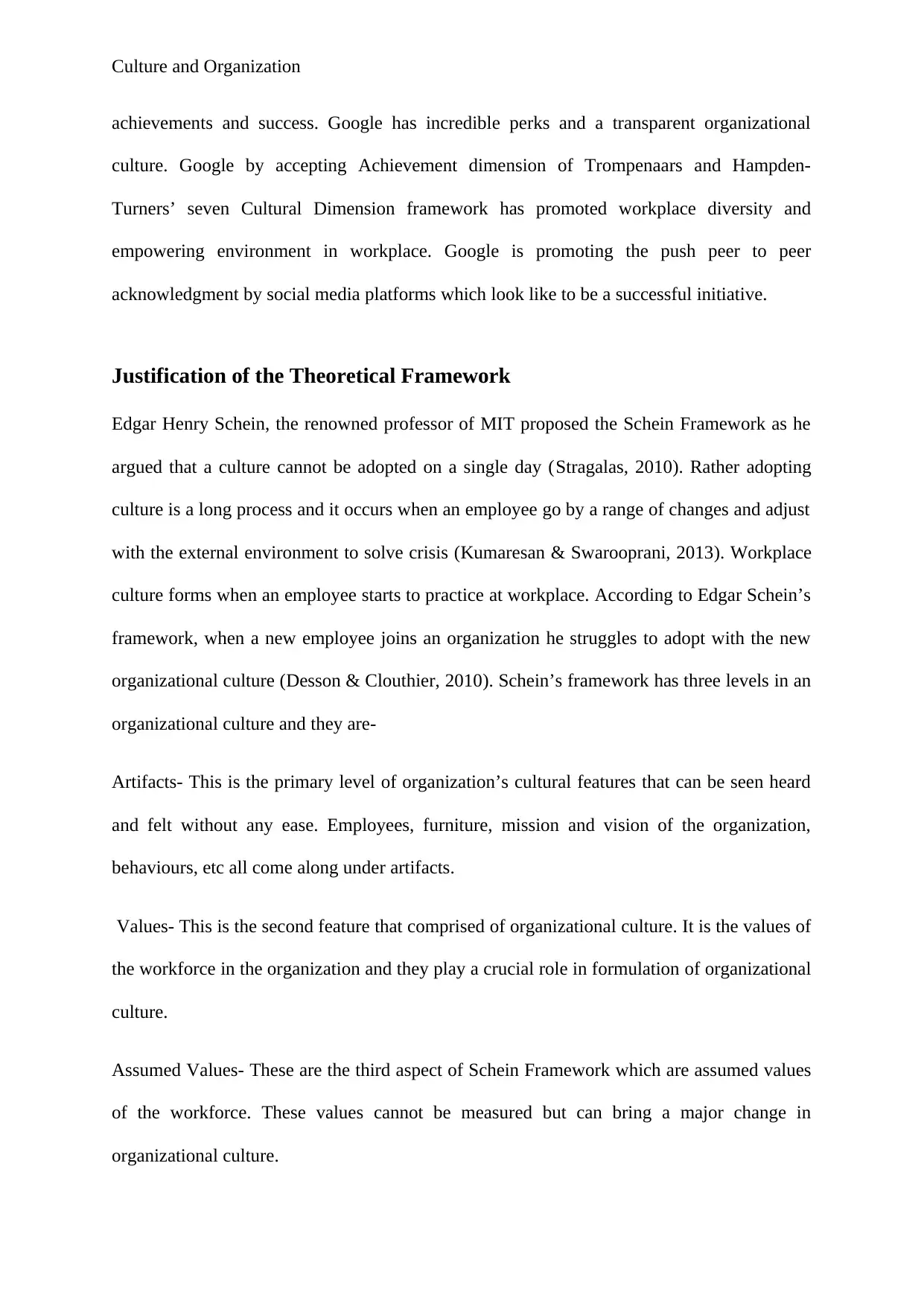
Culture and Organization
achievements and success. Google has incredible perks and a transparent organizational
culture. Google by accepting Achievement dimension of Trompenaars and Hampden-
Turners’ seven Cultural Dimension framework has promoted workplace diversity and
empowering environment in workplace. Google is promoting the push peer to peer
acknowledgment by social media platforms which look like to be a successful initiative.
Justification of the Theoretical Framework
Edgar Henry Schein, the renowned professor of MIT proposed the Schein Framework as he
argued that a culture cannot be adopted on a single day (Stragalas, 2010). Rather adopting
culture is a long process and it occurs when an employee go by a range of changes and adjust
with the external environment to solve crisis (Kumaresan & Swarooprani, 2013). Workplace
culture forms when an employee starts to practice at workplace. According to Edgar Schein’s
framework, when a new employee joins an organization he struggles to adopt with the new
organizational culture (Desson & Clouthier, 2010). Schein’s framework has three levels in an
organizational culture and they are-
Artifacts- This is the primary level of organization’s cultural features that can be seen heard
and felt without any ease. Employees, furniture, mission and vision of the organization,
behaviours, etc all come along under artifacts.
Values- This is the second feature that comprised of organizational culture. It is the values of
the workforce in the organization and they play a crucial role in formulation of organizational
culture.
Assumed Values- These are the third aspect of Schein Framework which are assumed values
of the workforce. These values cannot be measured but can bring a major change in
organizational culture.
achievements and success. Google has incredible perks and a transparent organizational
culture. Google by accepting Achievement dimension of Trompenaars and Hampden-
Turners’ seven Cultural Dimension framework has promoted workplace diversity and
empowering environment in workplace. Google is promoting the push peer to peer
acknowledgment by social media platforms which look like to be a successful initiative.
Justification of the Theoretical Framework
Edgar Henry Schein, the renowned professor of MIT proposed the Schein Framework as he
argued that a culture cannot be adopted on a single day (Stragalas, 2010). Rather adopting
culture is a long process and it occurs when an employee go by a range of changes and adjust
with the external environment to solve crisis (Kumaresan & Swarooprani, 2013). Workplace
culture forms when an employee starts to practice at workplace. According to Edgar Schein’s
framework, when a new employee joins an organization he struggles to adopt with the new
organizational culture (Desson & Clouthier, 2010). Schein’s framework has three levels in an
organizational culture and they are-
Artifacts- This is the primary level of organization’s cultural features that can be seen heard
and felt without any ease. Employees, furniture, mission and vision of the organization,
behaviours, etc all come along under artifacts.
Values- This is the second feature that comprised of organizational culture. It is the values of
the workforce in the organization and they play a crucial role in formulation of organizational
culture.
Assumed Values- These are the third aspect of Schein Framework which are assumed values
of the workforce. These values cannot be measured but can bring a major change in
organizational culture.
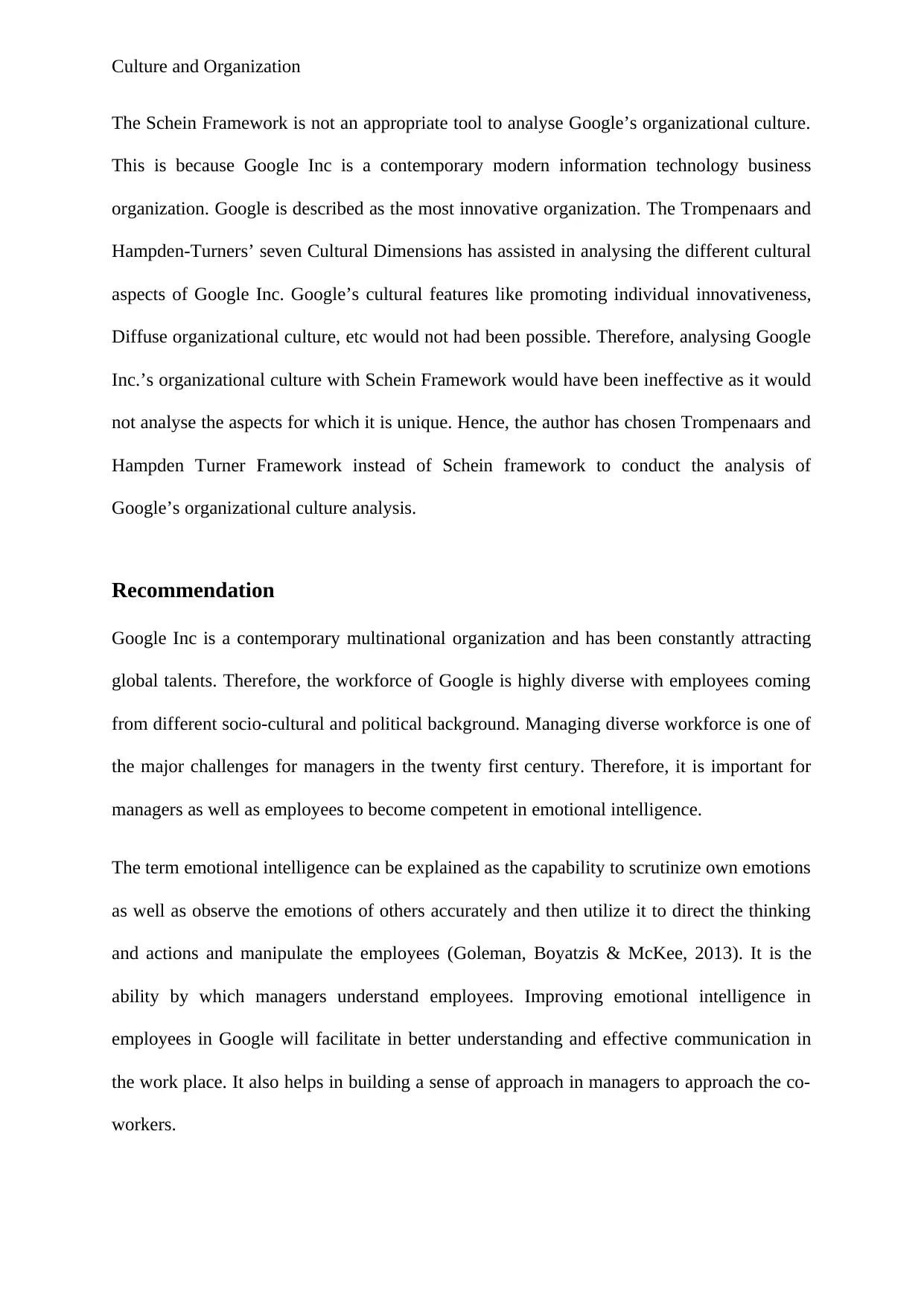
Culture and Organization
The Schein Framework is not an appropriate tool to analyse Google’s organizational culture.
This is because Google Inc is a contemporary modern information technology business
organization. Google is described as the most innovative organization. The Trompenaars and
Hampden-Turners’ seven Cultural Dimensions has assisted in analysing the different cultural
aspects of Google Inc. Google’s cultural features like promoting individual innovativeness,
Diffuse organizational culture, etc would not had been possible. Therefore, analysing Google
Inc.’s organizational culture with Schein Framework would have been ineffective as it would
not analyse the aspects for which it is unique. Hence, the author has chosen Trompenaars and
Hampden Turner Framework instead of Schein framework to conduct the analysis of
Google’s organizational culture analysis.
Recommendation
Google Inc is a contemporary multinational organization and has been constantly attracting
global talents. Therefore, the workforce of Google is highly diverse with employees coming
from different socio-cultural and political background. Managing diverse workforce is one of
the major challenges for managers in the twenty first century. Therefore, it is important for
managers as well as employees to become competent in emotional intelligence.
The term emotional intelligence can be explained as the capability to scrutinize own emotions
as well as observe the emotions of others accurately and then utilize it to direct the thinking
and actions and manipulate the employees (Goleman, Boyatzis & McKee, 2013). It is the
ability by which managers understand employees. Improving emotional intelligence in
employees in Google will facilitate in better understanding and effective communication in
the work place. It also helps in building a sense of approach in managers to approach the co-
workers.
The Schein Framework is not an appropriate tool to analyse Google’s organizational culture.
This is because Google Inc is a contemporary modern information technology business
organization. Google is described as the most innovative organization. The Trompenaars and
Hampden-Turners’ seven Cultural Dimensions has assisted in analysing the different cultural
aspects of Google Inc. Google’s cultural features like promoting individual innovativeness,
Diffuse organizational culture, etc would not had been possible. Therefore, analysing Google
Inc.’s organizational culture with Schein Framework would have been ineffective as it would
not analyse the aspects for which it is unique. Hence, the author has chosen Trompenaars and
Hampden Turner Framework instead of Schein framework to conduct the analysis of
Google’s organizational culture analysis.
Recommendation
Google Inc is a contemporary multinational organization and has been constantly attracting
global talents. Therefore, the workforce of Google is highly diverse with employees coming
from different socio-cultural and political background. Managing diverse workforce is one of
the major challenges for managers in the twenty first century. Therefore, it is important for
managers as well as employees to become competent in emotional intelligence.
The term emotional intelligence can be explained as the capability to scrutinize own emotions
as well as observe the emotions of others accurately and then utilize it to direct the thinking
and actions and manipulate the employees (Goleman, Boyatzis & McKee, 2013). It is the
ability by which managers understand employees. Improving emotional intelligence in
employees in Google will facilitate in better understanding and effective communication in
the work place. It also helps in building a sense of approach in managers to approach the co-
workers.
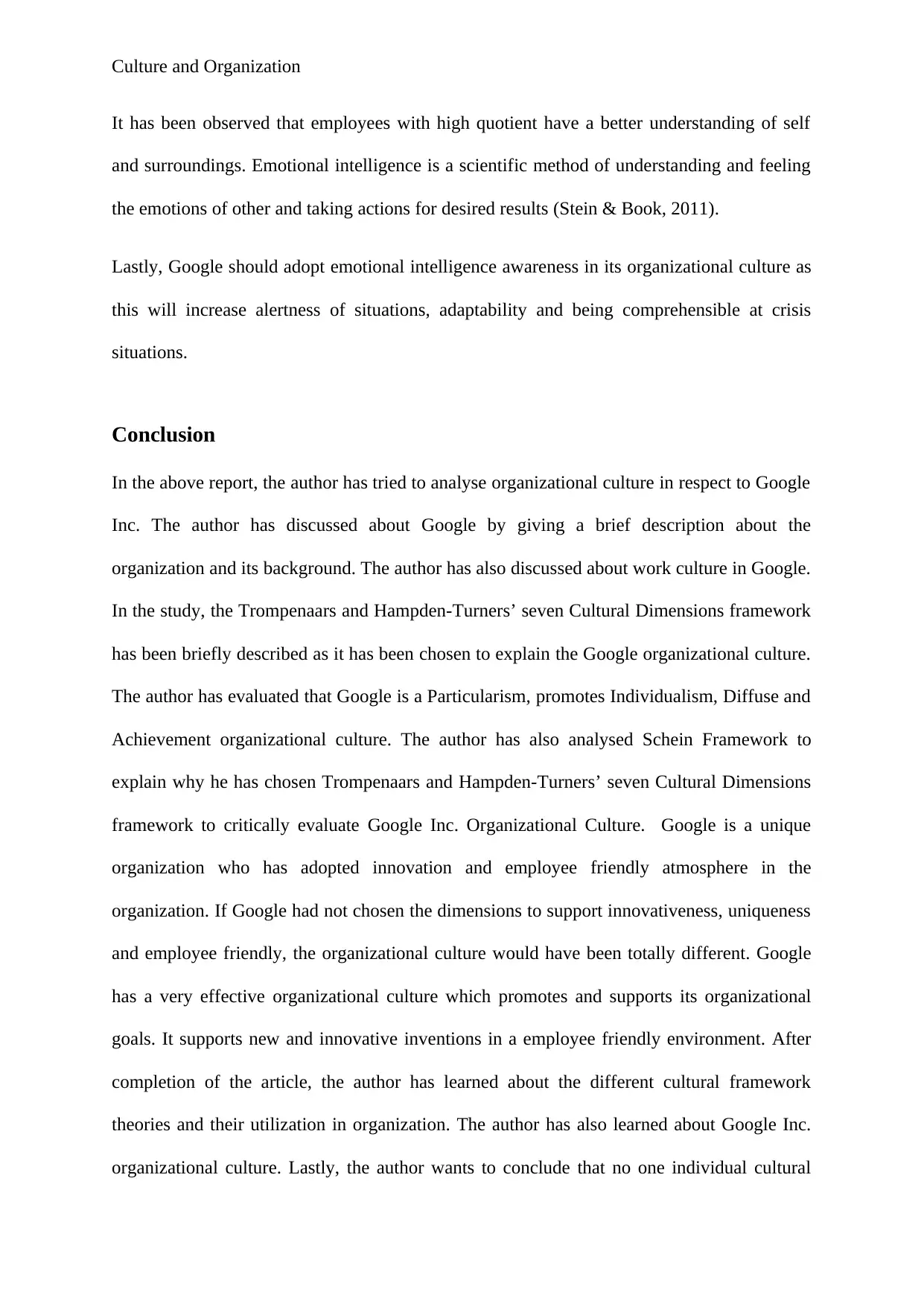
Culture and Organization
It has been observed that employees with high quotient have a better understanding of self
and surroundings. Emotional intelligence is a scientific method of understanding and feeling
the emotions of other and taking actions for desired results (Stein & Book, 2011).
Lastly, Google should adopt emotional intelligence awareness in its organizational culture as
this will increase alertness of situations, adaptability and being comprehensible at crisis
situations.
Conclusion
In the above report, the author has tried to analyse organizational culture in respect to Google
Inc. The author has discussed about Google by giving a brief description about the
organization and its background. The author has also discussed about work culture in Google.
In the study, the Trompenaars and Hampden-Turners’ seven Cultural Dimensions framework
has been briefly described as it has been chosen to explain the Google organizational culture.
The author has evaluated that Google is a Particularism, promotes Individualism, Diffuse and
Achievement organizational culture. The author has also analysed Schein Framework to
explain why he has chosen Trompenaars and Hampden-Turners’ seven Cultural Dimensions
framework to critically evaluate Google Inc. Organizational Culture. Google is a unique
organization who has adopted innovation and employee friendly atmosphere in the
organization. If Google had not chosen the dimensions to support innovativeness, uniqueness
and employee friendly, the organizational culture would have been totally different. Google
has a very effective organizational culture which promotes and supports its organizational
goals. It supports new and innovative inventions in a employee friendly environment. After
completion of the article, the author has learned about the different cultural framework
theories and their utilization in organization. The author has also learned about Google Inc.
organizational culture. Lastly, the author wants to conclude that no one individual cultural
It has been observed that employees with high quotient have a better understanding of self
and surroundings. Emotional intelligence is a scientific method of understanding and feeling
the emotions of other and taking actions for desired results (Stein & Book, 2011).
Lastly, Google should adopt emotional intelligence awareness in its organizational culture as
this will increase alertness of situations, adaptability and being comprehensible at crisis
situations.
Conclusion
In the above report, the author has tried to analyse organizational culture in respect to Google
Inc. The author has discussed about Google by giving a brief description about the
organization and its background. The author has also discussed about work culture in Google.
In the study, the Trompenaars and Hampden-Turners’ seven Cultural Dimensions framework
has been briefly described as it has been chosen to explain the Google organizational culture.
The author has evaluated that Google is a Particularism, promotes Individualism, Diffuse and
Achievement organizational culture. The author has also analysed Schein Framework to
explain why he has chosen Trompenaars and Hampden-Turners’ seven Cultural Dimensions
framework to critically evaluate Google Inc. Organizational Culture. Google is a unique
organization who has adopted innovation and employee friendly atmosphere in the
organization. If Google had not chosen the dimensions to support innovativeness, uniqueness
and employee friendly, the organizational culture would have been totally different. Google
has a very effective organizational culture which promotes and supports its organizational
goals. It supports new and innovative inventions in a employee friendly environment. After
completion of the article, the author has learned about the different cultural framework
theories and their utilization in organization. The author has also learned about Google Inc.
organizational culture. Lastly, the author wants to conclude that no one individual cultural
Paraphrase This Document
Need a fresh take? Get an instant paraphrase of this document with our AI Paraphraser
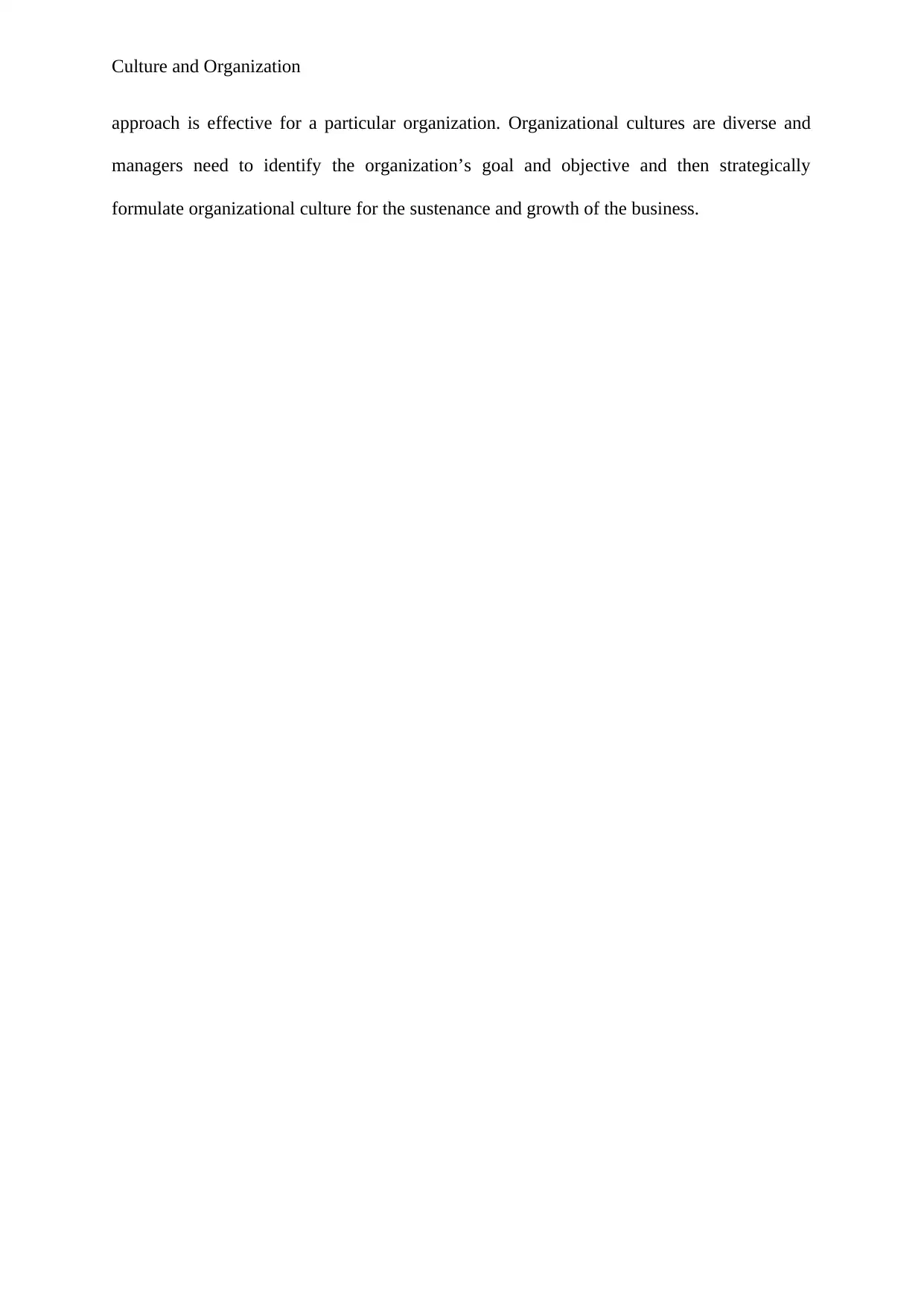
Culture and Organization
approach is effective for a particular organization. Organizational cultures are diverse and
managers need to identify the organization’s goal and objective and then strategically
formulate organizational culture for the sustenance and growth of the business.
approach is effective for a particular organization. Organizational cultures are diverse and
managers need to identify the organization’s goal and objective and then strategically
formulate organizational culture for the sustenance and growth of the business.
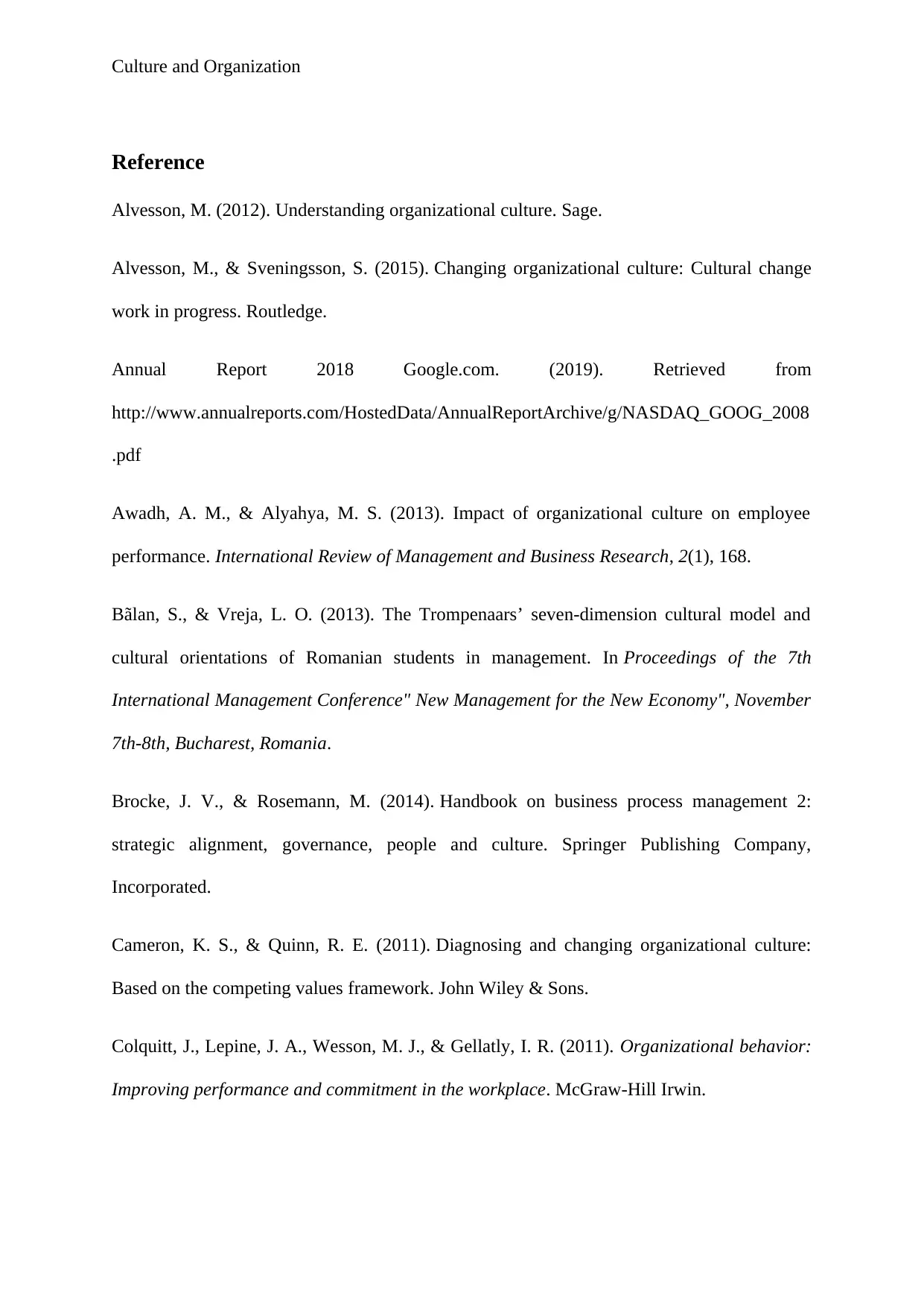
Culture and Organization
Reference
Alvesson, M. (2012). Understanding organizational culture. Sage.
Alvesson, M., & Sveningsson, S. (2015). Changing organizational culture: Cultural change
work in progress. Routledge.
Annual Report 2018 Google.com. (2019). Retrieved from
http://www.annualreports.com/HostedData/AnnualReportArchive/g/NASDAQ_GOOG_2008
.pdf
Awadh, A. M., & Alyahya, M. S. (2013). Impact of organizational culture on employee
performance. International Review of Management and Business Research, 2(1), 168.
Bãlan, S., & Vreja, L. O. (2013). The Trompenaars’ seven-dimension cultural model and
cultural orientations of Romanian students in management. In Proceedings of the 7th
International Management Conference" New Management for the New Economy", November
7th-8th, Bucharest, Romania.
Brocke, J. V., & Rosemann, M. (2014). Handbook on business process management 2:
strategic alignment, governance, people and culture. Springer Publishing Company,
Incorporated.
Cameron, K. S., & Quinn, R. E. (2011). Diagnosing and changing organizational culture:
Based on the competing values framework. John Wiley & Sons.
Colquitt, J., Lepine, J. A., Wesson, M. J., & Gellatly, I. R. (2011). Organizational behavior:
Improving performance and commitment in the workplace. McGraw-Hill Irwin.
Reference
Alvesson, M. (2012). Understanding organizational culture. Sage.
Alvesson, M., & Sveningsson, S. (2015). Changing organizational culture: Cultural change
work in progress. Routledge.
Annual Report 2018 Google.com. (2019). Retrieved from
http://www.annualreports.com/HostedData/AnnualReportArchive/g/NASDAQ_GOOG_2008
Awadh, A. M., & Alyahya, M. S. (2013). Impact of organizational culture on employee
performance. International Review of Management and Business Research, 2(1), 168.
Bãlan, S., & Vreja, L. O. (2013). The Trompenaars’ seven-dimension cultural model and
cultural orientations of Romanian students in management. In Proceedings of the 7th
International Management Conference" New Management for the New Economy", November
7th-8th, Bucharest, Romania.
Brocke, J. V., & Rosemann, M. (2014). Handbook on business process management 2:
strategic alignment, governance, people and culture. Springer Publishing Company,
Incorporated.
Cameron, K. S., & Quinn, R. E. (2011). Diagnosing and changing organizational culture:
Based on the competing values framework. John Wiley & Sons.
Colquitt, J., Lepine, J. A., Wesson, M. J., & Gellatly, I. R. (2011). Organizational behavior:
Improving performance and commitment in the workplace. McGraw-Hill Irwin.
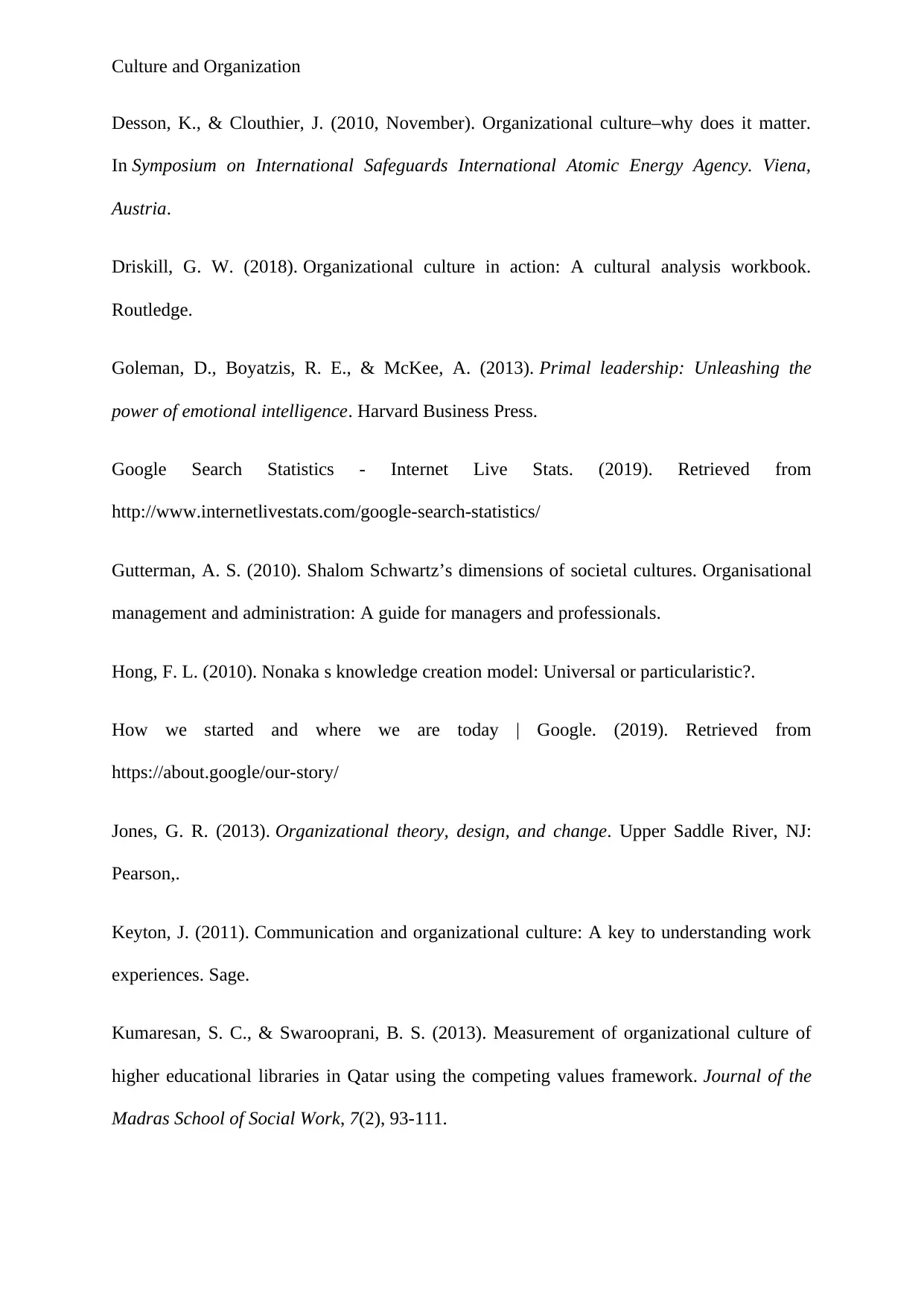
Culture and Organization
Desson, K., & Clouthier, J. (2010, November). Organizational culture–why does it matter.
In Symposium on International Safeguards International Atomic Energy Agency. Viena,
Austria.
Driskill, G. W. (2018). Organizational culture in action: A cultural analysis workbook.
Routledge.
Goleman, D., Boyatzis, R. E., & McKee, A. (2013). Primal leadership: Unleashing the
power of emotional intelligence. Harvard Business Press.
Google Search Statistics - Internet Live Stats. (2019). Retrieved from
http://www.internetlivestats.com/google-search-statistics/
Gutterman, A. S. (2010). Shalom Schwartz’s dimensions of societal cultures. Organisational
management and administration: A guide for managers and professionals.
Hong, F. L. (2010). Nonaka s knowledge creation model: Universal or particularistic?.
How we started and where we are today | Google. (2019). Retrieved from
https://about.google/our-story/
Jones, G. R. (2013). Organizational theory, design, and change. Upper Saddle River, NJ:
Pearson,.
Keyton, J. (2011). Communication and organizational culture: A key to understanding work
experiences. Sage.
Kumaresan, S. C., & Swarooprani, B. S. (2013). Measurement of organizational culture of
higher educational libraries in Qatar using the competing values framework. Journal of the
Madras School of Social Work, 7(2), 93-111.
Desson, K., & Clouthier, J. (2010, November). Organizational culture–why does it matter.
In Symposium on International Safeguards International Atomic Energy Agency. Viena,
Austria.
Driskill, G. W. (2018). Organizational culture in action: A cultural analysis workbook.
Routledge.
Goleman, D., Boyatzis, R. E., & McKee, A. (2013). Primal leadership: Unleashing the
power of emotional intelligence. Harvard Business Press.
Google Search Statistics - Internet Live Stats. (2019). Retrieved from
http://www.internetlivestats.com/google-search-statistics/
Gutterman, A. S. (2010). Shalom Schwartz’s dimensions of societal cultures. Organisational
management and administration: A guide for managers and professionals.
Hong, F. L. (2010). Nonaka s knowledge creation model: Universal or particularistic?.
How we started and where we are today | Google. (2019). Retrieved from
https://about.google/our-story/
Jones, G. R. (2013). Organizational theory, design, and change. Upper Saddle River, NJ:
Pearson,.
Keyton, J. (2011). Communication and organizational culture: A key to understanding work
experiences. Sage.
Kumaresan, S. C., & Swarooprani, B. S. (2013). Measurement of organizational culture of
higher educational libraries in Qatar using the competing values framework. Journal of the
Madras School of Social Work, 7(2), 93-111.
Secure Best Marks with AI Grader
Need help grading? Try our AI Grader for instant feedback on your assignments.
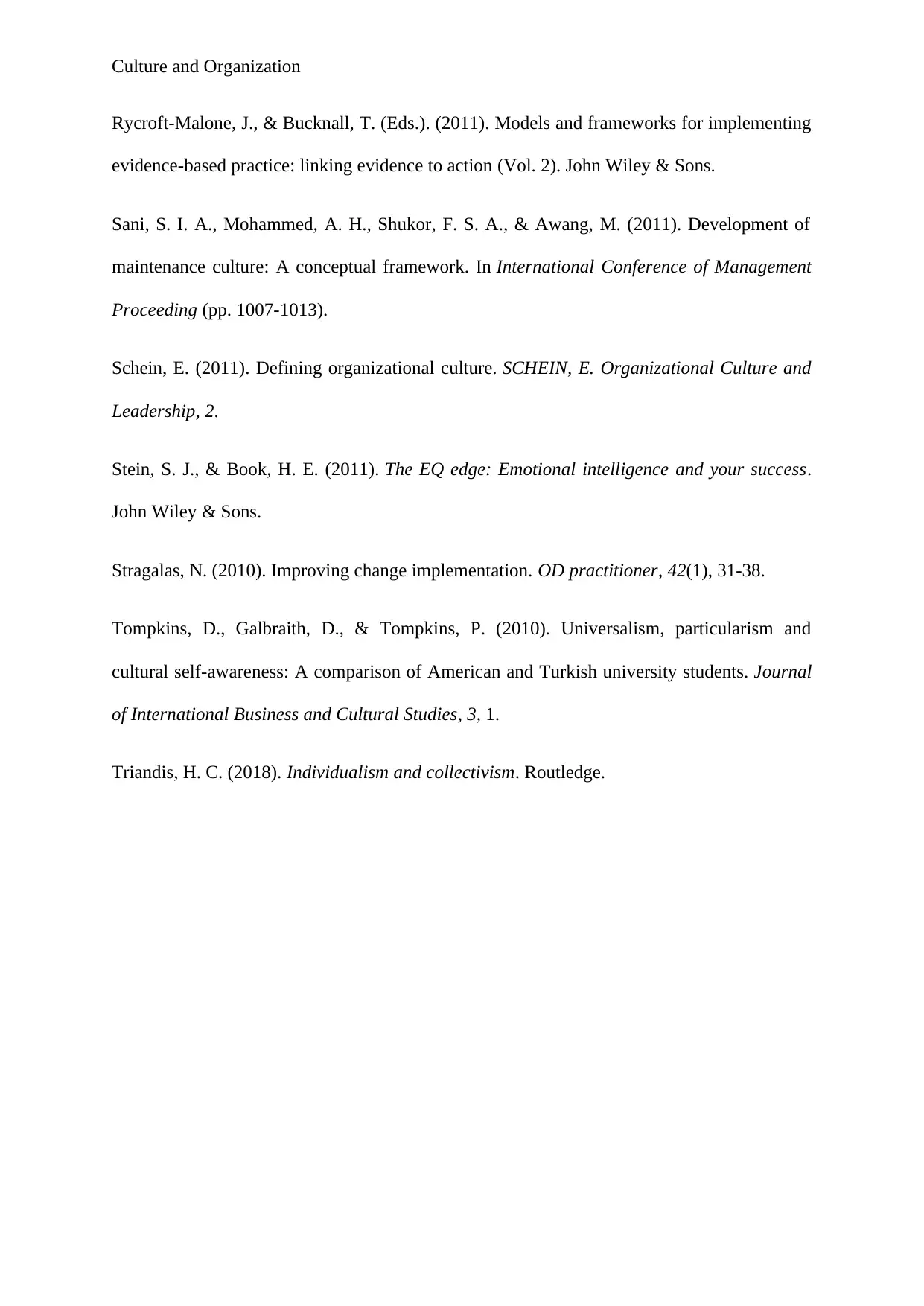
Culture and Organization
Rycroft-Malone, J., & Bucknall, T. (Eds.). (2011). Models and frameworks for implementing
evidence-based practice: linking evidence to action (Vol. 2). John Wiley & Sons.
Sani, S. I. A., Mohammed, A. H., Shukor, F. S. A., & Awang, M. (2011). Development of
maintenance culture: A conceptual framework. In International Conference of Management
Proceeding (pp. 1007-1013).
Schein, E. (2011). Defining organizational culture. SCHEIN, E. Organizational Culture and
Leadership, 2.
Stein, S. J., & Book, H. E. (2011). The EQ edge: Emotional intelligence and your success.
John Wiley & Sons.
Stragalas, N. (2010). Improving change implementation. OD practitioner, 42(1), 31-38.
Tompkins, D., Galbraith, D., & Tompkins, P. (2010). Universalism, particularism and
cultural self-awareness: A comparison of American and Turkish university students. Journal
of International Business and Cultural Studies, 3, 1.
Triandis, H. C. (2018). Individualism and collectivism. Routledge.
Rycroft-Malone, J., & Bucknall, T. (Eds.). (2011). Models and frameworks for implementing
evidence-based practice: linking evidence to action (Vol. 2). John Wiley & Sons.
Sani, S. I. A., Mohammed, A. H., Shukor, F. S. A., & Awang, M. (2011). Development of
maintenance culture: A conceptual framework. In International Conference of Management
Proceeding (pp. 1007-1013).
Schein, E. (2011). Defining organizational culture. SCHEIN, E. Organizational Culture and
Leadership, 2.
Stein, S. J., & Book, H. E. (2011). The EQ edge: Emotional intelligence and your success.
John Wiley & Sons.
Stragalas, N. (2010). Improving change implementation. OD practitioner, 42(1), 31-38.
Tompkins, D., Galbraith, D., & Tompkins, P. (2010). Universalism, particularism and
cultural self-awareness: A comparison of American and Turkish university students. Journal
of International Business and Cultural Studies, 3, 1.
Triandis, H. C. (2018). Individualism and collectivism. Routledge.
1 out of 17
Related Documents
Your All-in-One AI-Powered Toolkit for Academic Success.
+13062052269
info@desklib.com
Available 24*7 on WhatsApp / Email
![[object Object]](/_next/static/media/star-bottom.7253800d.svg)
Unlock your academic potential
© 2024 | Zucol Services PVT LTD | All rights reserved.





